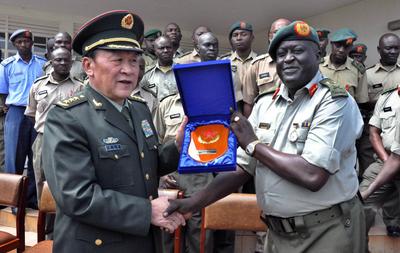In this sense, it is very similar to Japanese financial flows to China several decades ago, when Japan began its outward march with a large line of credit to China, which, at the time, was not credit-worthy either. Looking at the nature of Chinese development aid — and non-aid — to Africa provides insights into China’s strategic approach to outward investment and economic diplomacy, even if exact figures and strategies are not easily ascertained.
Chinese development finance in Africa involves two distinct types of financial flow: ODA and ‘other official flows’ (OOF). ODA as defined by the OECD refers to concessionary funding given to developing countries and multilateral institutions primarily for the purpose of promoting welfare and economic development in the recipient country. Funding must be ‘concessional in character’ (i.e. involving government subsidies) and loans must have a grant element of at least 25 per cent, using a 10 per cent discount rate.
While only concessional loans and grants qualify as ODA, governments also offer other official flows: funds for the donor country’s firms to subsidise or guarantee their private investment in recipient countries, military aid and export credits. These funds are reported as OOF. This category includes loans that are not concessionary in character, and official bilateral transactions — whatever their grant element — that are primarily export-facilitating in purpose.
China provides the equivalent of ODA through three instruments: grants, zero-interest loans and concessional (you hui dai kuan, or fixed-rate, low-interest) loans. These instruments finance Chinese government scholarships for African students; Chinese medical teams; ‘turn-key’ construction of stadiums, government buildings, telecommunications networks and other infrastructure; technical assistance teams in agriculture and other sectors; short-term training programs; youth volunteers; and material aid (the export of Chinese goods).
Grants and zero-interest loans were the primary instruments of China’s ODA until 1995, when concessional loans were introduced. According to the Chinese white paper on aid released in April this year, approximately 40 per cent of China’s aid is financed through grants. Zero-interest loans are also a mainstay of China’s aid. The debt-relief program launched by Beijing in 2000 targeted overdue zero-interest loans for cancellation, with RMB25.58 billion worth (US$3.76 billion) cancelled, and of this, RMB18.96 billion (US$2.79 billion) was cancelled in Africa.
Only large projects with a value of at least US$2.4 million, and that make a minimum 50 per cent use of Chinese goods and services, may be funded with concessional loans. China’s concessional-loan program in Africa has grown rapidly. At the end of 2005, China’s Export–Import Bank had cumulatively funded only about US$800 million in concessional loans in Africa, for 55 projects. Two years later, the number of African projects had risen to 87, and the cumulative value was about US$1.5 billion. And the government recently pledged US$10 billion in concessional/preferential credits for Africa, to be committed by 2012.
China also supplies other official funds that do not qualify as ODA. Three categories of loans are relevant here: export buyers’ credits, including preferential buyers’ credits (you hui mai fan xin dai) and commercial-rate, export commodity-secured or ‘mutual-benefit’ credits (hu hui dai kuan); official loans at commercial rates; and strategic lines of credit to Chinese companies.
For Africa, the OOF category provided by OECD members has normally been well below the level of funds provided on ODA terms. But this is not the case for China. China’s government-provided finance to Africa falls primarily into the OOF category, rather than ODA. As noted above, China’s official finance in Africa consists of grants, zero-interest loans, debt relief and concessional loans (which would all qualify as ODA), as well as preferential export credits, market-rate export buyers’ credits and commercial loans from Chinese banks (none of which would qualify as ODA).
In Africa, as elsewhere, Chinese aid agreements seem to follow diplomatic ties. China’s ODA does not appear to be given in larger amounts to resource-rich countries, as can be seen in flows to Nigeria and the Democratic Republic of Congo. Grants and zero-interest loans are distributed fairly evenly around the continent, while concessional loans fit a country’s ability to pay, either because it is middle income or because it will finance an income-generating project.
China’s economic push to ‘go global’ is coordinated by many policy instruments, including development aid. In this way, China’s strategy resembles Japan’s outward march more than it resembles the experience of other OECD countries. Chinese banks have developed instruments they believe can link Africa’s riches — its natural resources — to its development. Because they regard these resources as a source of wealth, they generally do not offer mutual-benefit loans (hu hui dai kuan) at concessional rates. And to the Chinese, even resource-poor countries like Ethiopia — whose balance sheets might not look good — sometimes have untapped capacity to service a future debt, if borrowed funds go toward productive projects. It remains to be seen whether fears about the sustainability of this debt are borne out.
Deborah Brautigam is Professor at the School of International Service, American University, and Adjunct Professor at the Department of Comparative Politics, University of Bergen. Professor Brautigam’s research was presented at China Update 2011. The annual China Update conference is hosted by the China Economy Program, in collaboration with the East Asia Forum, at the ANU in July. This article is a digest of a Professor Brautigam’s chapter ‘Chinese Development Aid in Africa’, in Jane Golley and Ligang Song (eds.) Rising China: Global Challenges and Opportunities. This book is the latest publication in the China Update Book Series, launched at the China Update conference every year.

